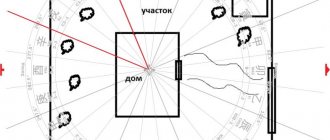WATERFALL, a free fall of water from a steep cliff.
Many waterfalls consist of a series of small falls, or cascades, where water falls from one ledge to another. The difference between a cascade and a series of thresholds is quite arbitrary. The term "rapid" is usually applied to a section of a river where water rushes down a rocky slope of lesser steepness. At some waterfalls, for example Yosemite in the Sierra Nevada Mountains (California, USA), during dry seasons the flow of water is greatly reduced and the free fall stops, since it practically does not come off the surface of the bedrock. Also on topic:
WATER RESOURCES
The genesis of waterfalls depends on the nature of the ledge that crosses the stream. Niagara Falls, on the border between the United States and Canada, formed where the Niagara River crosses a steep bedrock escarpment. This scarp is a layer of erosion-resistant rock overlying softer rock. The destruction of the latter under the influence of falling water leads to the erosion of a layer of strong rocks and its periodic collapse. Many famous waterfalls arose in this way.
In mountainous regions, high waterfalls are often confined to the mouths of hanging tributary valleys formed as a result of glaciers deepening the beds of the main rivers. Hanging valleys also formed in cases where the main stream of a river system cut in faster than its tributaries. Most of the high waterfalls in Norway, the Alps and glaciated mountains in western North America and New Zealand are confined to the mouths of hanging valleys.
Also on topic:
WATERFALL
WATERFALL
Other waterfalls were formed where mountain ranges or parts of them were uplifted, for example, as a result of faults in the earth's crust. Streams that do not have enough erosive power to incise to compensate for the uplift effect are toppled from the scarp along the fault.
What is a waterfall
A waterfall is a powerful fall of water from steep cliffs that are located across a river or stream. Water streams create a picturesque landscape, quickly descending along numerous ledges. A powerful and wide waterfall is also called a cataract. Those objects that fall hollowly are waterfall objects.
The geography of these natural sites is vast. They are found in almost every state. What is surprising is that most of the large specimens are found in two or three countries.
- Venezuelan Angel is the tallest in the world. Its height is 979 m. The entire volume of water cannot reach the ground and becomes like fog. Every year thousands of tourists come to Venezuela to see it. They are not even afraid that the path to the attraction leads through the jungle.
- South Africa has the second largest natural site called the Tugela. The five water cascades have a height of 948 m. Kon is the widest. It is located on the Mekong River in Cambodia and Laos. Its width is about 12 km.
- The most popular is Niagara Falls. It is located in the USA and millions of travelers come here every year. A special feature of a tourist site is its accessibility. Can be reached by public transport from the nearest city. Niagara Falls is briefly called Niagara because of its location on the river of the same name. Its height is only 52 m.
In Russia, similar objects are found in the mountainous areas of the Caucasus, Altai, and Urals. The most famous ones are named Kivach, Talnikovy, Tseysky. Most of them are accessible to visitors; the rest must be reached by air or river.
Types
See also: List of waterfalls by type
An example of an ephemeral waterfall. This one, when flowing, ends up in the Chagrin River.
- Ledge Falls
: Water falls vertically down a sheer cliff, partially in contact with bedrock.[10]
(eg Niagara Falls) Block/Leaf
: Water descends from a relatively wide stream or river.[3][10] - Classic
: Waterfalls with a lip whose drop height is almost equal to the width of the stream, form a vertical square shape.[3] - Curtain
: Waterfalls with projections that descend to a height greater than the width of the falling stream of water.[3]
: Fast moving water descends vertically, losing full contact with the bedrock surface.[10] Contact is usually lost due to the horizontal speed of the water before it falls. It always starts with a narrow stream. (eg Angel Falls)
- Punch bowl
: Water narrows and then spreads out into a wider pool.[10] (eg punch bowl falling)
: Descending water maintains contact with bedrock most of the time.[10] (eg Jog Falls)
- Slide
: Water slides downward, maintaining constant contact.[10]
: Water flows down a long, narrow strip.[10]
: A large amount of water passes through a narrow vertical passage.[10]
: Water spreads horizontally as it descends while remaining in contact with bedrock (eg Powerscourt Falls).[10]
: Water cascades down stone steps.[3][10] (eg Numa Falls)
: A series of waterfalls one after the other of approximately the same size, each with its own deep pool.[10] (eg Ebor Falls)
: Large, powerful waterfall.[10] (eg Victoria Falls)
: Distinctly separate streams of water form as it descends.[10]
: Any waterfall containing the element of ice or snow.[10]
: And Moulin is a waterfall on a glacier.
Some waterfalls are also distinguished by the fact that they do not flow continuously. Ephemeral
waterfalls flow only after rain or significant snow melt.[11][12][13]
Origin of waterfalls
Waterfalls appear in places where hard rock layers give way to soft ones. The water flow moves over rocks of different structures; fast-moving water keeps hard rocks intact, but destroys soft ones. It will take thousands of years for the rocks to be completely destroyed. After this, an equally impressive object will appear - a cliff. After some time, the waterfall itself is formed. A pond appears at its base. The base is the place under the waterfall.
They can also form due to earthquakes. When the earth's layers shift, deep cracks and sinkholes appear in the river bed. Some objects were born thanks to glaciers. A large accumulation of ice melts and flows from steep cliffs in a powerful waterfall stream.
Recommendations
- ^ a b c d f f
Carreck, Rosalind, ed.
(1982). Family Encyclopedia of Natural History
. Hamlyn Publishing Group. pp. 246–248. ISBN 978-0711202252. - Sutherland, Scott (23 March 2022). "Cloud Atlas moves into the 21st century with 12 new cloud types." Weather Network
. Pelmorex Media. Retrieved March 24, 2022. - ^ a b c d f
"Adventure". June 16, 2008. Retrieved November 10, 2016. - Pasternak, Grigory B.; Ellis, Christopher R.; Marr, Geoffrey D. (July 1, 2007). "Under the Horseshoe Falls, the jet and hydraulic jumps are loaded at the base." Water Resources Research
.
43
(7):W07449. Bibcode:2007WRR…. 43.7449P. doi:10.1029/2006wr005774. ISSN 1944-7973. - "Dr. Gregory B. Pasternak - Watershed Hydrology, Geomorphology, and Ecohydraulics:: Horseshoe Falls." pastornack.ucdavis.edu
. Retrieved June 11, 2022. - “Watch river erosion creating waterfalls and chasms.” Retrieved November 10, 2016.
- Wyrick, Joshua R.; Pasternak, Gregory B. (September 1, 2008). “Modeling the response of energy dissipation and hydraulic jump mode to channel heterogeneity at river stages.” Journal of Geophysical Research: Earth's Surface
.
113
(F3): F03003. Bibcode:2008JGRF..113.3003W. doi:10.1029/2007jf000873. ISSN 2156-2202. - Richard H. Beisel Jr., International Waterfall Classification System,
Outskirts Press, 2006 ISBN 1-59800-340-2 - Hudson, B. J. (2013) Waterfalls, science and aesthetics
- ^ a b c d f g gram h i j k l m p
“Worldwaterfalls.com”. September 11, 2015. Retrieved November 10, 2016. - https://www.terragalleria.com An ephemeral waterfall visible from inside the cave. Mammoth Cave National Park.
- https://www.kidsdiscover.com About Horsetail Falls, one of Yosemite's ephemeral waterfalls.
- https://www.wncwaterfalls Bird Falls.
- "All the waterfalls in India are shown." World Waterfall Database. Archived from the original on September 1, 2009. Retrieved June 20, 2010.
- “The World Waterfall Database is the most authoritative source of waterfall information on the Internet.” Archived from the original on July 12, 2011. Retrieved November 10, 2016.
How waterfalls are born in legends
People deified water slides and even made sacrifices to their stormy waters. Legends were made about them; according to beliefs, spirits lived in water streams. The Germanic tribes called them "Nix". They believed that spirits communicate with each other, which is why there is so much noise near water streams. Although in fact the noise depends on their size and the volume of falling water.
Many natural objects have their own legends about their origin. Iguazu Falls is no exception. They are located in Brazil and are considered the strongest in the world, as they flow about 10 million liters of water per second.
According to legend, the world was ruled by the snake-like M'Boy, who fell in love with the beautiful Naypi. Only her heart was occupied by the warrior of the Taroba tribe, with whom she fled in a canoe down the river. The snake got angry and hit the ground with its tail, it collapsed right in front of the lovers. They fell into the abyss that appeared and crashed. So Naypi turned into a rock, and Taroba became a palm tree above the river.
Formation
Formation of a Waterfall
Waterfalls usually form in the upper reaches of a river where lakes flow into steep mountains.[1] Because of their landscape position, many waterfalls occur over bedrock fed by a small area, so they may be ephemeral and flow only during periods of rainfall or significant snowmelt. The further downstream, the more perennial the waterfall can be. Waterfalls can have a wide range of widths and depths.
Aerial view of Victoria Falls on the Zambezi River in southern Africa.
The cloud formed by the fog is called cataractagenitis
.[2]
When a river flows through resistive bedrock, erosion occurs slowly and mainly due to the impacts of sediment carried by the water on the rock, whereas downstream erosion occurs more rapidly.[1][3] As the watercourse increases its speed at the edge of the waterfall, it can uproot material from the riverbed if the riverbed is cracked or more susceptible to erosion. Hydraulic jets and hydraulic jumps at the toe of a waterfall can create large forces that erode the bottom,[4] especially when the forces are amplified by water deposits. Horseshoe-shaped waterfalls concentrate erosion at a central point, also exacerbating channel changes below the waterfall.[5] The process known as "scouring" involves the local erosion of a potentially deep hole in bedrock due to turbulence. whirlpools rotate stones on the bed, drill them out. Therefore, sand and rocks carried by the watercourse increase the erosive capacity.[1] This causes the waterfall to cut deeper into the riverbed and retreat upstream. Often, over time, a waterfall will retreat back, forming a canyon or gorge downstream, as it retreats upstream, it will deepen into the ridge above it.[6] The rate of retreat of the waterfall can reach one and a half meters per year.[1]
Often the rock layer just below the more stable shelf will be softer, meaning that undercutting by splash will occur here to form a shallow cave-like formation known as a rock shelter under and behind the waterfall. Eventually, the outcropping, more resistant bedrock will collapse under pressure, adding rock blocks to the base of the waterfall. These blocks of rock are then broken into smaller boulders. abrasion as they collide with each other, and they also erode the base of the waterfall abrasion, creating a deep small pool in the gorge downstream.
Streams can become wider and shallower just above waterfalls due to flow around the rock ledge, and there is usually a deep area directly below the waterfall due to the kinetic energy of the water falling to the bottom. However, research into the taxonomy of waterfalls has shown that waterfalls can be wider or narrower above or below a waterfall, so that almost anything is possible given the right geological and hydrological conditions.[7] Waterfalls usually form in rocky areas due to erosion. After a long period of complete formation, the water falling from the ledge will recede, forming a horizontal pit parallel to the waterfall wall. Eventually, as the hole gets deeper, the waterfall collapses and a steep section of riverbed takes its place.[1] In addition to gradual processes such as erosion, earth movement caused by earthquakes or landslides or volcanoes can cause differences in the height of the earth, which interferes with the natural flow of water and leads to waterfalls.
Sometimes the river flows over a large step in the rocks, which may have been formed by a fault line. Waterfalls can occur along the edge of a glacial trench, where a stream or river enters the glacier and continues to flow into the valley after the glacier has retreated or melted. The large waterfalls in Yosemite Valley are examples of this phenomenon, which is called hanging valley. Another reason why hanging valleys can form is where two rivers meet and one flows faster than the other.[1]
Waterfalls can be grouped into ten broad classes based on the average volume of water present at the falls (which depends on both the average flow of the waterfall and its height), using a logarithmic scale. Class 10 waterfalls include Niagara Falls, Paulo Afonso Falls and Khone Falls.
Other notable waterfall classes include: Victoria Falls and Kaieteur Falls (Class 9); Rhine Falls and Gullfoss (8th grade); Angel Falls and Dettifoss (7th grade); Yosemite Falls, Lower Yellowstone Falls, and Umphang Thee Lor Sue Waterfall (grade 6); and Sutherland Falls (grade 5).[8]
Types of waterfalls
River beds differ in width, relief, and volume of water, which is why there are different waterfalls. According to the features of the relief and what the descending water streams look like, they can be divided into the following types:
- Cascade. The rock on which the water flows has a stepped structure.
- Fan-shaped. Becomes wider from the top to the base.
- Block. The stream goes down like a huge wall.
- Cup-shaped. The water flow spreads across a vast surface depression.
- Longline. Many streams of different sizes and other parameters.
- Plunging. The water mass falls strictly vertically.
- Multi-step. Similar streams that belong to the same basin.
- Segmented. The water is divided into a number of blocks.
There are different definitions of a waterfall based on the volume of descending water flows and the size of the ledge:
- Cascade. Several objects located nearby.
- Water slide. A calm waterfall without a sharp drop in flow.
- Cataract. A large object in which a large volume of water flows in a wide wall from a small height.
Often large specimens are a series of small rapids and cascades. Almost all of them are located in the territories of several countries. Their main feature is movement. The continuous flow of water causes the cliff to collapse and move up the river bed.
How do waterfalls move?
They can move independently along the river. If the base consists of soft rocks, then water will gradually erode them. So they collapse, and the beginning of the flow moves higher along the river bed.
The cliff from which Niagara Falls descends is composed of hard limestones. Behind them are soft shale rocks on which a stream of water flows. Therefore, the bottom becomes deeper, stones break off from hard rocks under the influence of their own weight and powerful water pressure. It moves on average 30 cm per year. Since its inception, it has moved 11 km.
Researchers
Alexander von Humboldt (1820s) “The Father of Modern Geography” Humboldt primarily marked waterfalls on maps for river navigation purposes.
Oscar von Engeln (1930s). Published Geomorphology: Systematic and Regional, this book had an entire chapter dedicated to waterfalls and is one of the earliest examples of published work on waterfalls.
R. W. Young (1980s) wrote "Waterfalls: Form and Process." This work made waterfalls a much more serious research topic for modern geophysicists.[9]
Benefits of waterfalls
Streams of water not only calm the human nervous system, but also have healing properties. Water descending from a height forms water dust, and under the influence of sunlight, ions with a negative charge appear in it. Such dust has a positive effect on health, because it is filled with phytoncides from nearby plants in large quantities.
A waterfall is such a limitless source of energy that it is widely used in the construction of hydroelectric power stations.
The only trouble for humans is that stormy streams cannot be controlled. This poses a problem for shipping. Therefore, in places where there are waterfalls, special canals are built that allow ships and liners to make a protected path.
Feng Shui paintings with water
The Feng Shui waterfall (pictures are presented in the article) is, as mentioned above, a source of vitality and constant changes for the better. If you notice that there is stagnation in your life, things stubbornly do not move forward, and you yourself seem to be endlessly marking time in one place, then the element of water will help you give a tangible impetus.
Place a painting or photograph of a waterfall in your home, and you will be surprised to find that positive changes will not be long in coming. In particular, Feng Shui advises those people who live in densely populated cities, remote from wildlife, to resort to this trick. And for residents of apartments in high-rise buildings, this technique will regularly relieve the stress that accumulates during the day and eliminate the feeling of immobility of life and stagnation (this is very important in apartment buildings, where the flow of Qi energy is initially disrupted).
In addition, water is also a symbol of abundance, wealth and good luck. It attracts material well-being, a favorable outcome of any financial transactions, prosperity and luxury into the home. A picture of a waterfall has no less power than a real decorative waterfall if it is placed in the right place, from the point of view of Feng Shui philosophy.
Underwater waterfalls
More recently, researchers have discovered that there are underwater waterfalls located at the bottom of the sea or ocean. About ten such objects were found. There are probably more of them, but it is not yet possible to fully study this amazing phenomenon.
They appear for two reasons:
- different densities of water (due to differences in temperatures of adjacent areas and different amounts of salt);
- unevenness of the seabed.
When there are zones nearby that differ in density, and the seabed is relief, the densest water masses descend lower, and the lighter ones rise higher. It turns out that this is a waterfall - a similar effect is created by falling water.
Scientists have discovered 7 similar objects in the waters of the world's oceans. They are several times larger in size than terrestrial ones. The largest is located in the Atlantic Ocean between Greenland and Iceland. It is 350 times larger than the tallest in the world. The width of the Atlantic giant is 150 km, and it consumes 30 thousand cubic meters per second.
The most spectacular object is located off the island of Mauritius. The illusion of falling water is due to the refraction of light, current, and the combination of silt, sand and coral deposits. Nature has created such an unusual phenomenon that it is impossible to take your eyes off. True, it can only be viewed from a helicopter.
Do waterfalls disappear?
The waterfalls, although slowly, move. Every year, large specimens retreat several centimeters. Climate change and global warming also affect their future. Thus, the world's largest Victoria Falls is threatened by drought. During extreme heat, it turns into a trickle. Sharp temperature changes have a negative impact not only on its greatness, but also on the biocenosis and the local economy.
Over time, the volume of water in the stream may change. It depends on the availability of water in the river that forms it. Even the largest waterfall can dry up for a while. This is most influenced by weather conditions and the level of precipitation.
Valleys of tumbling rivers
The number of waterfalls in a given area directly depends on how many rivers flow in a given area and the complexity of the terrain. If only one river flows, there is only one falling stream. But if there are a sufficient number of rivers and mountain streams in the area, then the abundance of rivers flowing from the slopes is often amazing.
For example, the second name of Norway is the Land of Waterfalls: due to the huge number of rivers and high rocky mountains, they can be seen almost everywhere, while fourteen of them are the highest in Europe, and three are among the eight highest waterfalls in the world.
In addition, there are many countries that, although they cannot be characterized in the same way as Norway, on their territories you can see the most beautiful waterfalls in the world, located one after another - the valley of waterfalls. One of the most famous places of this kind is Yosemite National Park: the Valley of Waterfalls located on its territory is the only place in the world where many large and world-famous waterfalls are located in a small area.
But in Europe, the most famous valley of Lauterbrunnen waterfalls is located in the Swiss Alps: there are 72 cascading streams, some of which are more than a hundred meters high, and the most popular waterfall in this area is Staubbach - its height exceeds 300 meters.
Another valley of waterfalls is located in the Caucasus near Sochi. These are “Thirty-three waterfalls on the Dzhegosh stream”, located one after another for half a kilometer. The highest waterfall reaches only ten meters.











